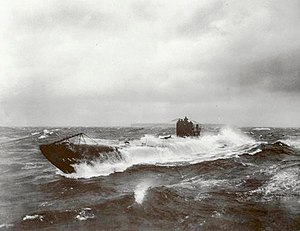SM UB-106
 From Wikipedia the free encyclopedia
From Wikipedia the free encyclopedia
 UB-148 at sea, a U-boat similar to UB-106. | |
| History | |
|---|---|
| Name | UB-106 |
| Ordered | 6 / 8 February 1917[1] |
| Builder | Blohm & Voss, Hamburg |
| Cost | 3,714,000 German Papiermark |
| Yard number | 312 |
| Launched | 21 July 1917[2] |
| Commissioned | 7 February 1918[2] |
| Fate | Sunk 15 March 1918, later raised; surrendered 26 November 1918; used for explosive trials and dumped on beach 1921; sold for scrap 1921 |
| General characteristics [2] | |
| Class and type | Type UB III submarine |
| Displacement | |
| Length | 55.30 m (181 ft 5 in) (o/a) |
| Beam | 5.80 m (19 ft) |
| Draught | 3.70 m (12 ft 2 in) |
| Propulsion |
|
| Speed |
|
| Range |
|
| Test depth | 50 m (160 ft) |
| Complement | 3 officers, 31 men[2] |
| Armament |
|
| Service record | |
| Commanders: | |
| Operations: | No patrols |
| Victories: | None |
SM UB-106 was a German Type UB III submarine or U-boat in the German Imperial Navy (German: Kaiserliche Marine) during World War I. She was commissioned into the German Imperial Navy on 7 February 1918 as SM UB-104.[Note 1]
UB-106 was lost in an accident on 15 March 1918, but was later raised and recommissioned.[2] She was surrendered to the Allies at Harwich on 26 November 1918. After passing into British hands, UB-97 was towed to Falmouth along with five other U-boats [Note 2] for use in a series of explosive test trials by the Royal Navy in Falmouth Bay, in order to find weaknesses in their design. Following her use during 13/17 January 1921, UB-106 was dumped on Castle Beach and sold to R. Roskelly & Rodgers on 19 April 1921 for scrap (for £125), and partially salvaged over the following decades, although parts remain in situ.[5]
Construction
[edit]She was built by Blohm & Voss of Hamburg and following just under a year of construction, launched at Hamburg on 21 July 1917. UB-106 was commissioned early the next year under the command of Oblt.z.S. Hugo Thielmann. Like all Type UB III submarines, UB-106 carried 10 torpedoes and was armed with a 8.8 cm (3.46 in) deck gun. UB-106 would carry a crew of up to 3 officer and 31 men and had a cruising range of 7,420 nautical miles (13,740 km; 8,540 mi). UB-106 had a displacement of 519 t (511 long tons) while surfaced and 649 t (639 long tons) when submerged. Her engines enabled her to travel at 13.3 knots (24.6 km/h; 15.3 mph) when surfaced and 7.4 knots (13.7 km/h; 8.5 mph) when submerged.
References
[edit]Notes
[edit]Citations
[edit]- ^ Rössler 1979, p. 66.
- ^ a b c d e Gröner 1991, pp. 25–30.
- ^ Helgason, Guðmundur. "WWI U-boat commanders: Hugo Thielmann". German and Austrian U-boats of World War I - Kaiserliche Marine - Uboat.net. Retrieved 9 March 2015.
- ^ Helgason, Guðmundur. "WWI U-boat commanders: Max Schmidt". German and Austrian U-boats of World War I - Kaiserliche Marine - Uboat.net. Retrieved 9 March 2015.
- ^ Dodson, Aidan; Cant, Serena (2020). Spoils of War: the fate of enemy fleets after the two World Wars. Barnsley: Seaforth. pp. 50–52, 99, 129. ISBN 978-1-5267-4198-1.
Bibliography
[edit]- Bendert, Harald (2000). Die UB-Boote der Kaiserlichen Marine, 1914-1918. Einsätze, Erfolge, Schicksal (in German). Hamburg: Verlag E.S. Mittler & Sohn GmbH. ISBN 3-8132-0713-7.
- Gröner, Erich; Jung, Dieter; Maass, Martin (1991). U-boats and Mine Warfare Vessels. German Warships 1815–1945. Vol. 2. Translated by Thomas, Keith; Magowan, Rachel. London: Conway Maritime Press. ISBN 0-85177-593-4.
- Rössler, Eberhard (1979). Die deutschen U-Boote und ihre Werften: eine Bilddokumentation über den deutschen U-Bootbau; in zwei Bänden (in German). Vol. I. Munich: Bernard & Graefe. ISBN 3-7637-5213-7.